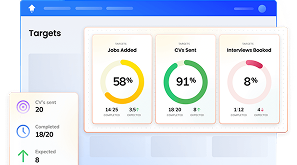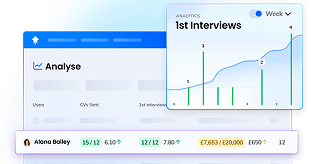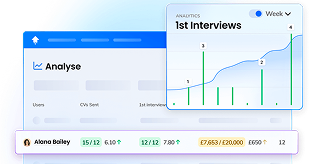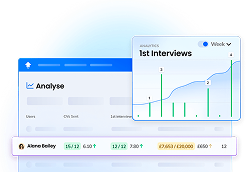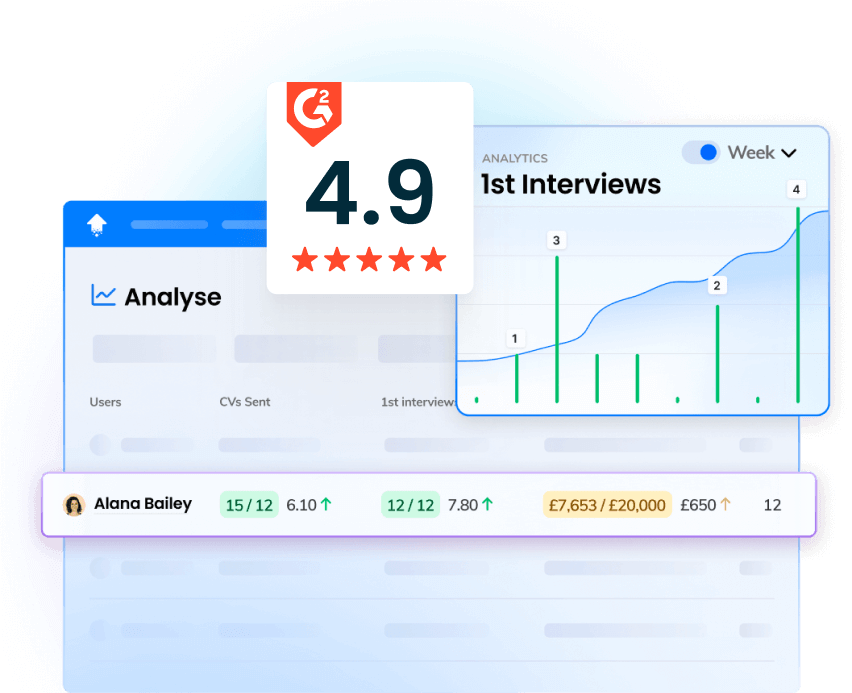Introduction
2024 in just four words? “A year of uncertainty”.
Last year was a rollercoaster for the UK recruitment industry. It started off with feelings of cautious optimism: economic growth showed promise and demand for talent remained high. But as inflation persisted and a new government (with new policies) was voted in, businesses became more careful with hiring.
It may come as no surprise that, as a result, permanent placements took a hit while contract roles gained traction - a direct side effect of companies seeking flexibility amid uncertain times. In addition to all this, rising employer costs (including higher National Insurance contributions) only added to the challenge, forcing many businesses to rethink their workforce strategies.
Most recruitment agencies know all too well that what worked last year won’t necessarily work this year. But when it comes to understanding the bigger picture (what’s changing, what’s staying the same and how to benchmark against the competition) clear, reliable data is hard to come by.
So we’re here to fix that!
In this report, we break down key trends for jobs added, placements and booked revenue across micro-, small, mid-sized and large agencies. Split into permanent vs. contract, you’re guaranteed to find game-changing insights for your 2025 strategy.
Following the success of our first State of Recruitment report, this second edition brings you no-fluff, high-value takeaways based on real data from 300+ agencies and thousands of consultants worldwide. Whether you’re scaling, stabilising or strategising for the year ahead, these insights will help guide your next move.
Let’s get into it...
2024 Trends: Micro-Agencies (1-9 Consultants)
Jobs Added
Throughout the year the volume of perm jobs sourced saw a declining trend, moving from its peak of 20 jobs sourced per agency per month in January to just 8 in December. On the other hand, the number of contract jobs sourced per agency per month showed very little fluctuation throughout 2024.
It’s worth noting that the average monthly perm jobs sourced per agency was almost 2x that of contract jobs, a scale that this report has found tips towards equal balance as agencies grow in size.
Placements
Despite the steady stream in volume of contract jobs sourced (see previous graph), contract placements show slightly less consistency, ranging between 6-10 contract placements made per month per agency. Permanent placements typically ranged from 4-5 per month per agency throughout 2024, with the exception of December where the average dropped to 3.
It’s worth noting that the average volume of monthly placements per agency (7.75) sits very close to the average number of jobs sourced monthly per agency (8.1) for agencies of this size. This is likely due to some contract jobs serving more than one placement during 2024 as opposed to each role being filled once at a near-100% fill rate.
Revenue Booked
In 2024, the average monthly revenue per agency was remarkably similar for permanent (£37.3k) and contract (£35.7k) placements. However, despite these close averages, permanent revenue was far more stable, fluctuating between £33k and £41k, while contract revenue varied significantly, ranging from £16k to £73k.
Contract revenue started strong in January at £72.5k but declined throughout the year, reaching its lowest point of £16.4k in December. Interestingly, both contract and permanent revenue followed similar month-on-month trends, rising and falling in tandem - except in January, when contract revenue was nearly double that of permanent placements, and in March when permanent revenue peaked while contract revenue dipped.
TL;DR
Jobs Added:
- Throughout 2024, the volume of perm jobs sourced by micro-agencies saw a declining trend, dropping from a peak in January to its lowest in December.
- Meanwhile the number of contract jobs sourced showed very little fluctuation. This suggests that, despite a consistent need for contract workers, the demand for permanent roles diminished as the year progressed, perhaps due to economic instability and a cautious approach from businesses.
- It's also worth noting that, on average, the monthly perm jobs sourced by micro-agencies were almost double that of contract jobs, which is different to what was seen in small agencies, which experienced a more balanced split.
Placements:
- Despite a steady stream of contract jobs being sourced, contract placements for micro-agencies was inconsistent throughout the year. Permanent placements remained fairly consistent, except for a drop in December, which could be attributed to a slowdown in hiring activity that typically occurs at the end of each year.
Revenue Booked:
- In 2024, the average monthly revenue for perm and contract placements was remarkably similar for micro-agencies. However, while perm revenue was relatively stable, contract revenue varied significantly, starting strong in January but declining throughout the year, reaching its lowest point in December. This suggests that while contract roles may bring high initial gains, perm revenue provided a much more reliable income stream for micro-agencies during this time.
- Interestingly, contract revenue was nearly double that of perm revenue in January, which may be linked to increased demand for contract workers at the start of the year.
Key Takeaways:
- Adaptability is paramount. The recruitment market was anything but predictable in 2024, so being able to adapt quickly was crucial. The considerable swings in contract revenue highlight the importance of keeping a close eye on finances and being prepared to adjust strategies as needed.
- Recognise the value of both markets. Despite sourcing more perm jobs, the revenue generated from contract roles was almost identical on average across the year, so neither market should be overlooked.
- Monitor contract revenue closely. This revenue stream was more volatile, so it's important to track it carefully month-to-month as it’s proven to be subject to dramatic swings. While both contract and perm revenues tended to follow similar monthly trends, that wasn't always the case.
- Consistency has a clear advantage. Perm placements provided a reliable and consistent revenue stream, even if the overall volume was lower. The stability offered by perm roles might allow agencies to make more strategic decisions and improve business planning.
2024 Trends: Small Agencies (10-49 Consultants)
Jobs Added
Whereas the volume of permanent jobs added peaked in January, contract jobs per agency peaked in October. Both line graphs exhibit very similar shapes as they spike and dip together throughout 2024.
Unlike micro-agencies (where the average no. of contract jobs added per agency per month is nearly twice that of permanent jobs), the average no. of jobs added per agency per month for perm vs. contract are closer in number for small agencies.
We know that one likely cause for October’s peak volumes is that an especially high volume of agencies using OneUp launched Halloween competitions and leaderboards around this time in an effort to ramp efforts throughout Q4 before the end of the year (something our clients talk about at length in our Carrot & Stick podcast episode titled ‘Incentive Strategies to Supercharge Your Start to 2025’).
Other explanations for the surge in perm jobs added during Q4 could be accelerated hiring before year-end budget freezes, transitioning contract workers into permanent roles for long-term stability or sector-specific trends where certain industries gear up for Q4 demand (e.g. retail, healthcare, education, etc.).
Placements
Unlike micro-agencies (1-9 consultants), small agencies in 2024 saw a significantly higher number of contract placements than permanent placements. While perm placements remained relatively stable, contract placements showed greater volatility and a higher overall volume.
For the typical agency of this size 2024, the month with the highest volume of contract placements made was November, and May/July for perm placements.
Revenue Booked
Contract revenue proved to be extremely volatile in 2024 for small agencies, reaching its lowest point in April and peaking in July - ranging from £50k-£93k in any given month. In contrast, perm revenue proved to be more stable, with month-on-month booked revenue fluctuating between a much tighter range of £79-98k.
Similar to what we saw for micro-agencies (1-9 consultants), booked perm revenue peaked in April where contract revenue saw its worst performance throughout 2024. It’s also worth noting that perm revenue dipped to its lowest average (around the £80k mark) at either end of the year.
As expected, booked revenue plummeted in December following the steep decline in jobs added - a pattern commonly seen across the industry each year as agencies wind down before the holiday season, marking what is typically known as the off-season of recruitment.
TL;DR
Jobs Added:
- In 2024, the volume of permanent jobs added by small agencies peaked in January, whereas contract jobs peaked in October. This suggests that while there was an initial demand for perm roles, as the year progressed, market conditions like rising unemployment may have shifted the focus more towards contract roles, as companies were more cautious about long-term hires.
- The number of perm and contract jobs sourced were closer for small agencies compared to micro-agencies, where contract jobs were nearly twice the number of perm jobs, suggesting small agencies have a more balanced split in job sourcing.
Placements:
- Small agencies saw a significantly higher number of contract placements compared to permanent placements throughout 2024.
- Unlike micro-agencies, where perm placements were more consistent, for small agencies contract placements showed greater volatility, reflecting the fluctuations in demand and the impacts of market instability.
- The highest volume of contract placements occurred in November and perm placements peaked in May/July, perhaps due to the increased cost of employment towards the end of the year.
Revenue Booked:
- Contract revenue proved to be volatile, reaching its lowest point in April and peaking in July, while perm revenue was more stable and fluctuated between a tighter range. This could be attributed to the cautious hiring approaches and rising unemployment, causing companies to opt for flexible contract-based hiring throughout the year.
- Interestingly, perm revenue peaked in April when contract revenue was at its lowest, suggesting that, for small agencies, perm revenue may be the go-to during times of market instability.
Key Takeaways:
- Don't underestimate the importance of perm roles. While contract roles generated higher overall volumes, perm revenue proved to be more stable. Therefore, maintaining a focus on permanent placements may help manage fluctuations in income.
- Be prepared for volatility in contract placements. Contract placements experienced highs and lows, and it's important to be prepared to quickly adapt strategies to address the impact of shifts in client demand.
- Stay agile. Small agencies should focus on remaining flexible and ready to adapt to the changing market conditions. Given the shifts in revenue and placements, being able to pivot quickly may be crucial to success in an unpredictable economic climate.
- Perm revenue can provide a solid foundation. Despite the volatility of contract placements and revenue, perm revenue offered greater stability throughout 2024, suggesting that agencies should continue to invest in this area as a reliable income stream.
2024 Trends: Mid-Sized Agencies (50-99 Consultants)
Jobs Added
The average volume of permanent jobs added per agency peaked in January at 104, and saw its lowest volume in December at 53 - nearly half the volume seen in January. While the average amount of permanent jobs sourced per agency ranged from 53-104 throughout 2024, the average amount of contract jobs sourced per agency saw a slightly narrower range of 70-103.
As expected, job volumes fell off a cliff in December - a pattern commonly seen across the industry each year as agencies wind down before the holiday season, marking what is typically known as the recruitment industry’s off-season for hiring activity.
Placements
The average volume of contract placements per agency nosedived in August - as did perm placements in June and September. Despite the permanent placements graph painting a more dramatic picture it was contract placements that proved to be more unpredictable, ranging from anywhere from 73 to 169 placements per agency per month throughout 2024 (compared to a range of 23-31 average monthly placements per agency for perm employment).
For agencies of this size, the most successful month for placements was March for perm employment (avg. of 31 placements) and November for contract employment (avg. of 169 placements).
Revenue Booked
Unlike what we saw for micro-agencies (1-9 consultants) and small agencies (10-49 consultants) contract employment is now the frontrunner when it comes to booked revenue, generating around £68k more per month per agency than perm employment for agencies of this size.
However, as we’ve seen consistently throughout this report across all agency sizes, booked contract revenue has a much broader month-on-month range (£175-499k) compared to its permanent counterpart (£208-298k).
The data shows that the average mid-sized agency experienced huge spikes in booked contract revenue during May and October 2024, suggesting that these were some of the most profitable periods for agencies of this size.
TL;DR
Jobs Added:
- Despite fluctuations in the labour market, mid-sized agencies saw a relatively stable range of contract jobs being sourced. In the first half of the year, as the economy showed signs of recovery (though inflation remained elevated) there was a peak in the average number of perm jobs sourced per agency.
- The number of perm jobs sourced dropped by nearly half from January to December, possibly due to the rising unemployment rates and businesses becoming more cost-conscious.
Placements:
- Contract placements fluctuated significantly (73–169 per month), with a sharp drop in August, likely due to a cooling job market from July to September.
- Permanent placements were steadier (23–31 per month) but dipped in June and September, peaking in March. The divergence between perm and contract placements suggests economic pressures (namely rising borrowing costs and wage inflation) drove hiring caution.
- The November peak in contract placements may reflect businesses mitigating employment costs toward year-end.
Revenue Booked:
- Average monthly booked contract revenue had a much broader range (£175-499k) compared to perm revenue (£208-298k).
- The data shows that mid-sized agencies experienced significant spikes in booked contract revenue during May and October, perhaps suggesting that the rise in wage growth and businesses seeking assistance in negotiating competitive salary packages had a positive impact on revenue.
Key Takeaways:
- Volatility was the name of the game. The recruitment market in 2024 was anything but predictable, and mid-sized agencies saw big swings in contract revenue. It is important to keep a close eye on revenue and be prepared to adapt strategies in response to changing market conditions.
- Don't underestimate contract revenue. Though perm roles may seem more reliable, contract revenue is where the money is for agencies of this size, generating on average £68k more per month than perm revenue. It's crucial to focus on this area.
- Be prepared for fluctuations. The broader range of contract revenue means that it is important to track this carefully month-to-month as it is subject to dramatic swings. Understanding these trends and being able to adapt to them will be essential to agency success.
- Strategic planning is crucial. Whilst contract placements proved to be more unpredictable, with a wider range month-to-month, the data indicates that contract revenue was often double that of perm revenue. Therefore, agencies of this size should be focused on capitalising on the financial benefits of contract placements, despite their unpredictable nature.
2024 Trends: Large Agencies (100+ Consultants)
Jobs Added
Throughout 2024, the average number of jobs added per agency per month was remarkably similar for both permanent and contract employment. Notably, as agencies grow in size, the split between perm and contract jobs trends closer to an even 50/50 distribution.
For agencies of this size, job volumes dropped sharply in December across both perm and contract roles. On average, January saw the highest number of perm jobs added per agency (199), while July had the peak for contract jobs (211 per agency).
Placements
The two graphs closely mirror each other in shape and month-on-month trends with the exception of November, where contract placements peaked before the December slope and perm placements continued to descend. In August, contract placements plummeted by 92% from their January peak of 643, standing out dramatically. In contrast, permanent placements show a more moderate decline, dropping 37% from their peak of 52 in January to 33 per agency per month.
Interestingly, the contract placements graph closely resembles that of mid-sized agencies (50-99 consultants) where both graphs peak in January, but experiencing an extreme decline in August. The same can’t be said for contract placements however, where the graphs between the two agency sizes are very different.
Revenue Booked
Both perm and contract revenues for large agencies experienced a volatile year in 2024 with several ups and downs. Perm revenue was higher on average, and there was a sharp peak in perm revenue in September while the rest of the year was marked by a general decline for perm revenue especially. Contract revenue began the year relatively high before experiencing a decline into February, suggesting a potential slow start to the year for contract revenue.
Overall, perm employment proved to be more profitable for large agencies in 2024 but not more stable or predictable. Where one revenue type soared the other often tumbled, making it all the more clear how maintaining a balance of both contract and perm operations was critical to staying competitive in 2024.
TL;DR
Jobs Added:
- Throughout 2024, the average number of jobs added per agency per month was remarkably similar for both permanent and contract roles.
- January saw the highest number of perm jobs added, while July had the peak for contract jobs, perhaps reflecting the initial signs of economic recovery and the later cooling of the job market.
- Notably, job volumes dropped sharply in December across both perm and contract roles, possibly due to the rising unemployment and businesses pausing hiring due to anticipated higher employment costs.
Placements:
- While contract placements peaked in November before the December slope, perm placements continued to descend.
- The contract placements graph closely resembled that of mid-sized agencies, where both graphs peaked in January but experienced a dramatic decline in August. This suggests that the mid-sized and large agencies were more affected by UK economic conditions that impacted contract placements.
Revenue Booked:
- Both perm and contract revenues experienced a volatile year with several ups and downs.
- Perm revenue was higher on average, with a sharp peak in September, while the rest of the year was marked by a general decline, perhaps reflecting the cautious approach to hiring in the latter half of the year.
- Contract revenue began the year relatively high before declining in February, suggesting a potential slow start to the year for contract revenue.
- Overall, perm employment proved to be more profitable for large agencies in 2024 but not more stable or predictable, and maintaining a balance of both contract and perm operations was critical to staying competitive.
- As expected, booked revenue nosedived in December following the steep decline in jobs added - a pattern commonly seen across the industry each year as agencies wind down before the holiday season, marking what is typically known as the off-season of the recruitment industry.
Key Takeaways:
- Diversification is key. The recruitment market was anything but predictable in 2024, with both perm and contract revenues experiencing volatility. Maintaining a balance of both contract and perm operations was crucial to staying competitive.
- Keep an eye on contract placements. The dramatic drop in contract placements in August highlights the importance of monitoring this area closely and being prepared for unexpected shifts in demand.
- Don't underestimate perm revenue! Although perm revenue saw a general decline for much of the year, it still proved to be more profitable on average, and therefore shouldn't be overlooked as an important revenue stream.
- Adaptability is everything. The economic fluctuations throughout the year meant that agencies needed to remain agile and adaptive in their strategies, particularly given that the interplay of macro-environmental factors required agencies to pivot quickly.
2024 Trends: Cross-Comparison Between Agency Sizes
Jobs Added
On average, recruitment businesses sourced more permanent jobs than contract jobs across all agency sizes in 2024 with the exception of mid-sized agencies (50-99 consultants) who sourced slightly more contract jobs than perm jobs.
Placements
As agency size increases, as does the percentage of all placements made which are contract placements.
While permanent placements don’t dramatically increase as agencies scale (4.3 per agency per month for micro-agencies vs. 40.7 per agency per month for large agencies), a large agency made almost 53x more contract placements on average per month in 2024 than a micro-agency did (7.8 per agency per month for micro-agencies vs. 411.8 per agency per month for large agencies).
Revenue Booked
In 2024, permanent revenue exceeded contract revenue for most agency sizes. However, mid-sized agencies (50–99 consultants) were an exception, booking 30% more contract revenue per month on average than permanent revenue. This aligns with our job volume comparison graph (see previous), which shows that, unlike micro-, small and large agencies, mid-sized agencies sourced the majority of their jobs from contract placements.
Consultant Benchmarks by Agency Size
Looking for some perm vs. contract benchmarks to see how your business measured up? Here’s what it took for the average recruiter to fill one placement in 2024 according to their agency’s size:
Micro-Agencies (1-9 Consultants)
Small Agencies (10-49 Consultants)
Mid-Sized Agencies (50-99 Consultants)
Large Agencies (100+ Consultants)
Consultant Benchmarks: Cross-Comparison Between Agency Sizes
During 2024 as agency size increased, the average booked revenue per permanent placement also increased. However, the average booked revenue per contract placement decreased—except for mid-sized agencies, where each contract placement was worth more (£2,604 per consultant) than in small agencies (£2,265 per consultant).
This graph helps explain why, despite large agencies primarily focusing on contract placements at the agency level (see the ‘2024 Averages: Cross-Comparison between Agency Sizes’ section above), the total booked revenue from permanent placements still exceeds that of contract placements.
Some reasons as to why such extreme differences in booked revenue per placement can be seen for large agencies in particular include:
- Large agencies may prioritise placing candidates in senior or specialist permanent roles, which tend to have higher placement fees.
- They may operate a high-volume contract recruitment model, where margins per placement are lower but made up for in quantity. If this were the case, agencies may be willing to accept lower per-placement values in exchange for long-term client relationships and repeat business where the value of contract roles lies in recurring revenue (rather than the one-time fee that comes with perm employment).
- Where large agencies operate a high-volume contract model, they may secure multiple placements for one job at a higher rate than other agency sizes (this is also indicated in the ‘Consultant Benchmarks’ in the previous section, where large agencies typically need 0.4 jobs to fill 1 contract placement), in which case fees would be lower per placement.
- Competition in the contract market may be more aggressive for agencies of this size, leading to lower fees per contract placement.
- Large agencies may serve different industries or clients compared to smaller agencies. If they cater to industries with lower contract rates (think volume-based staffing in sectors like industrial, call centres or healthcare), this could also explain the lower average booked revenue per contract placement.
2025 Predictions
So you've seen the data from 2024 and read through all its insights and may be left wondering: "okay, now what about 2025?". Don't worry, we won't leave you hanging - here's what fellow industry experts have to save about the year ahead:
“As AI reshapes recruitment, job descriptions, CVs and applications are becoming increasingly AI-driven, making it harder for recruiters to cut through the noise. Agencies that have spent the past two years leveraging AI to enhance CRM, automate tasks, and understanding their data will thrive.
In 2025, firms embracing AI-driven automation, skills-based hiring, data-driven decisions, and fully integrated tech stacks will stand out. The most strategic will solidify their advisor role, command higher fees, and use technology to drive candidate/client satisfaction and revenue growth."
- Wendy McDougall, CEO at Firefish
"By the end of 2025, the industry will begin to realise they need an AI and Automation strategy for their every action. I believe that the most forward agencies will have started to fully adopt Agentic AI with autonomous agents “working” in place of FTE.
I believe agencies will be (mostly) back in the office 3-4 days per week and, after what looks to be a rough Q1 and Q2, will boom once the NA economy starts to recover.
Those who have spent the next 2 quarters level setting and putting in the work will be the winners in 2026."
- Nick Beecroft, Head of UK New Business at The Access Group
“I think we will see a significant rise in AI and Automation. The volume of work that this will create for agencies will be immense and those that will be successful will have to take the human aspect of their role to the next level. I think we will continue to see the larger firms return fully to offices and boutique firms and collectives springing up to cater for those not wanting a return.”
- Andy Hallett, Managing Director at RecWired
"Staying updated with AI advancements will be crucial for recruiters to maintain a competitive edge. A significant number of companies are expected to invest in recruitment automation, with AI-driven tools handling tasks such as CV screening, candidate matching and initial interview scheduling. As a result, AI will streamline hiring processes, reducing time-to-hire and operational costs (e.g. AI-powered screening tools can analyse CVs and match candidates to roles based on skills, saving time and improving accuracy).
It can also run personalised and tailored messaging sequences with candidates in process to maximise CX. Given the drive in efficiency and "doing more with less" (Better productivity per head and higher output), data analytics tools will continue to become more widely adopted as a "must have" for recruitment businesses. I also expect to see more recruitment companies continue to return to more office based working with some hybrid (in some cases no hybrid at all anymore)."
- Sam Crisp, Founder at Axonas Consulting
"I believe adopting new technology has emerged as a top priority for 2025 with agencies aware that it is even more crucial to stay competitive. Business development but also client retention in an increasingly competitive marketplace also stand out as focal points.
In a market where adapting quickly is essential, this focus on BD and technology shows the industry’s readiness to thrive in the face of change. Platforms with AI and automation have already gained traction in recent years with this being ever more significant going forward this year with the benefits of saving time and improved candidate and client experience now clear.
Further adoption of these platforms that have understood the problems they solve in the recruitment sector is expected."
- Steven Mead, Senior Account Executive at JobAdder
“AI and automation will automate more and more menial tasks meaning recruiters will spend more time focused on conversations. However, the standard of business development will drop as recruiters shy away from it and lean on tech to fill the gap.
The best/most successful recruiters will embrace the cold call as well as face to face methods of BD. The 180 model of recruitment will continue its downward trend and the 360 model will become more popular again... The key profile of a successful recruiter will be a BD focused generalist working in a niche area of expertise by Q3 2025."
- Drew Burkin, Senior Business Development Manager at Devyce
Methodology
This report is based on data collected from 322 recruitment agencies between 01 Jan 2024 - 31 Dec 2024.
Please note:
- This report’s financial benchmarks take into consideration the following currencies: AED, AUD, BHD, BMD, BRL, CAD, CHF, CNY, COP, CZK, DKK, EUR, GBP, HKD, HUF, ILS, INR, JPY, KRW, KWD, KYD, MXN, MYR, NOK, NZD, OMR, PLN, QAR, RON, SAR, SEK, SGD, THB, TRY, TWD and ZAR.
- For consistency, all revenue figures have been converted to GBP by using average historical conversion rates for each month covered by the dataset.
- Sample size somewhat varies throughout the year as customers onboard/off-board the OneUp Sales platform.
- Data exceeding 3 standard deviations from the mean of any metric (e.g. jobs added, placements, etc.) was classified as anomalous and excluded from analysis.
Thanks for reading and we hope you enjoyed this content!
For queries, feedback or suggestions about future content you’d like to see from OneUp Labs, please email us at marketing@oneupsales.co.uk
If you’re looking to create an accountable, resilient sales team that uses data to drive performance, chat to a member of our team to learn more.
